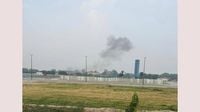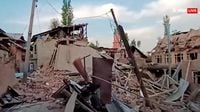A powerful explosion rocked Lahore, Pakistan, on Thursday morning, May 8, 2025, just a day after India executed a series of airstrikes targeting terror camps in Pakistan and Pakistan-occupied Kashmir (PoK). This escalation in violence follows the tragic attack on April 22, where 26 civilians, mostly Hindu tourists, lost their lives in Pahalgam, Kashmir, prompting India's military response.
The blasts were reported on Walton Road in the Gopal Nagar and Naseerabad areas, near Walton Airport. Eyewitnesses described a series of loud explosions that sent shockwaves through the city. Sirens were also heard in the vicinity, indicating a heightened state of alert among local authorities.
According to police sources, a UAV drone was shot down near Walton Air Field shortly after the blasts occurred. The bomb disposal squad has been dispatched to the areas affected by the explosions to assess the situation and ensure public safety.
India's airstrikes, carried out under the operation named 'Operation Sindoor,' targeted nine key terror hubs associated with groups such as Jaish-e-Mohammed (JeM), Lashkar-e-Taiba (LeT), and Hizbul Mujahideen. Indian Defence Minister Rajnath Singh stated that the operation was a measured response to the Pahalgam attack, emphasizing that the strikes were conducted with precision to avoid civilian casualties.
"Through Operation Sindoor, India has used its 'Right to Respond' to the attack on its soil," Singh declared. He praised the Armed Forces for their thoughtful execution of the operation and reiterated that no civilian population was harmed during the strikes. The operation's primary aim was to dismantle the infrastructure used for training terrorists, thereby breaking their morale.
The airstrikes successfully destroyed targets in both Pakistan and PoK, with four targets hit inside Pakistan and five in PoK. Significant locations included the Markaz Subhan Allah in Bahawalpur, the Markaz Taiba in Muridke, and several camps in Muzaffarabad and Kotli.
Masood Azhar, the chief of JeM, reportedly lost ten family members in the strikes, including his elder sister and brother-in-law. This development has further escalated tensions between India and Pakistan, with both nations on high alert.
In response to the airstrikes, Pakistani Prime Minister Shehbaz Sharif directed the military to prepare for potential retaliation. The Pakistani military's response is still unfolding, with officials emphasizing the need to protect national sovereignty in light of India's aggressive actions.
As the situation develops, airports in Lahore, Karachi, and Islamabad temporarily ceased operations due to security concerns. The ongoing tensions have prompted fears of a broader conflict between the two nuclear-armed neighbors.
Local media reports have indicated that the blasts in Lahore might be linked to retaliatory actions, although details remain unclear. The Pakistani government has not confirmed any casualties from the explosions thus far.
International observers are closely monitoring the situation, as the potential for escalation remains high. The United Nations and various countries have called for restraint from both sides, urging dialogue to prevent further violence.
As the dust settles on Lahore's streets, the reverberations of this conflict echo far beyond the region. The international community watches with bated breath, hoping for a de-escalation of hostilities and a return to diplomatic discussions.
The blasts in Lahore represent a significant turning point in the ongoing conflict between India and Pakistan. With both nations poised for military engagement, the future remains uncertain. The need for dialogue and peaceful resolution has never been more critical.
As the investigation into the Lahore blasts continues, authorities are working diligently to ensure the safety of citizens and prevent further incidents. The Pakistani public remains on edge, grappling with the reality of living in a region fraught with conflict and instability.
In the wake of the blasts, social media is abuzz with reactions from both sides of the border, reflecting the deep-seated animosities and fears that characterize Indo-Pak relations. The narrative of victimhood and heroism plays out in real-time, complicating the already tense atmosphere.
In conclusion, the blasts in Lahore serve as a stark reminder of the fragility of peace in South Asia. As both India and Pakistan navigate this perilous moment, the hope for a diplomatic solution remains a beacon of light amidst the chaos.


